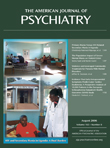Binge Eating Associated With Internal Carotid Artery Aneurysm
To the Editor: Prevalence rates of DSM-IV binge eating disorder and intracranial aneurysm have been estimated at 1% (1) and 2%–5% (2) . To our knowledge, there has been no report of comorbidity of these two conditions. We describe a case of a patient with internal carotid artery aneurysm presenting with symptoms similar to binge eating disorder.
“Mrs. A,” a 32-year-old married woman with two children, presented at a psychiatric clinic in Jan. 2003 with depressive symptoms and uncontrollable binge eating episodes that had been recurrent for 2 months. She became fixated with her body weight and waist circumference. Psychosexual stressors from her husband’s extramarital affairs were also identified. Neither compensatory behavior nor a history of anorexia was elicited.
Despite alleviation of her depressed mood and preoccupation with body weight following treatment with paroxetine (30 mg/day) and weekly psychotherapy for 4 months, her binge eating episodes persisted. She was then lost to follow-up for several months. Subsequently, she relapsed and presented with the following at her visit in Jan. 2004: binge eating episodes, overconcern with waist circumference, depressed mood, decreased self-esteem, psychomotor agitation, episodic headaches, blurred visions, increased body weight (from 47 kg to 54 kg in 4 months), and increased severity of stress from marital conflict. There was no identified temporal relationship between her headaches and hyperphagia episodes. Similar to prior pharmacotherapy, fluoxetine doses (40 mg/day) were effective in reducing her symptoms of depression and body image distortion rather than controlling her binge eating impulse.
Her physical examination revealed no negative findings except galactorrhea. Neither papilledema nor other focal neurological sign was identified at neurological examination. Her serum level of prolactin was within normal range (8.27 ng/ml). A magnetic resonance image of her pituitary disclosed an engorged vessel from the right internal carotid artery A1 segment compressed on the right optic chiasma and hypothalamus ( Figure 1 ). An angiography showed a wide-based aneurysm (maximum width: 5 mm; height: 4 mm) at the supraclinoid segment of the right internal carotid artery. Her blurred vision and headaches subsided after microsurgical decompression. She did not suffer from any binge eating episode or body image distortion during the postoperation follow-up for 20 months.

An association between bulimia and central nervous system lesions and increased intracranial pressure has been reported previously (3) . To our knowledge, Mrs. A is the first reported case of internal carotid artery aneurysm presenting with a binge eating disorder. The disproportional treatment responses and evidence for focal neurological signs suggest the necessity for organic workup. It is advisable to perform detailed physical assessment, endocrinological evaluation, and possible neuroimaging studies in patients with binge eating disorder who have unexpected responses to traditional treatment strategies. Furthermore, our case report may provide additional evidence of a neurological basis of binge eating disorder. One limitation to this report is that it lacks analysis of the potential neural substrates for binge eating disorder.
1. Hans WH, Daphne VH: Review of the prevalence and incidence of eating disorders. Int J Eat Disord 2003; 34:383–396Google Scholar
2. Pfohman M, Criaddle LM: Epidemiology of intracranial aneurysm and subarachnoid hemorrhage. J Neurosci Nurs 2001; 33:39–41Google Scholar
3. Krahn DD, Mitchell JE: Case report of bulimia associated with increased intracranial pressure. Am J Psychiatry 1984; 141:1099–100Google Scholar



